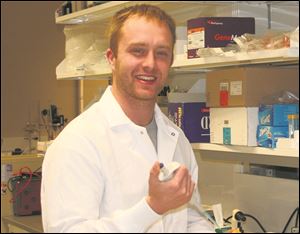
UT researchers study effects of Ecstasy on the brain
12/4/2017
For someone caught up in the heat of the moment at a local dance club or rave scene, taking ecstasy may not seem like a life-changing event. But as studies have shown, this decision may indeed be life-altering.
A frequent consequence of taking ecstasy is a trip to the hospital. This is because the short-term effects of ecstasy can produce life-threatening increases in temperature and heart rate, and hallucinations.

Stuart Collins is a PhD student in the neurosciences and neurological disorders at the University of Toledo college of medicine.
According to the Substance Abuse and Mental Health Services Administration, more than 17,000 hospital visitations resulted from individuals who had taken ecstasy in 2008 alone. Ecstasy has been known as a drug of abuse since the 1970s, but it only exploded into popular abuse in the mid-1990s. A recent survey from the National Institute of Drug Abuse has found that 11 million people have taken ecstasy at least once.
The long-term effects of ecstasy have also been documented in many studies. These studies show that ecstasy damages neurons, which are our core brain cells. This damage can last for months and even longer.
The goal of our research is to understand the mechanisms by which ecstasy damages the brain. Specifically, the focus of our project is to determine how a subset of neurons is decreased by ecstasy and how this affects brain function. These particular neurons (parvalbumin interneurons) provide inhibitory signaling to the brain to filter out nonimportant information.
This is similar to noise cancelling headphones that can filter out extra noise, allowing the listener to hear the music more clearly. Ecstasy causes a loss of these cells in an area of the brain associated with learning and memory. Therefore, such a loss is believed to reduce the ability of the brain to form new memories. This is correlated with numerous studies that have shown learning deficiencies in people that have taken Ecstasy.
Using techniques that can measure brain activity, we have shown that inhibitory signaling is reduced in the brains of rats that had been given Ecstasy. This supports our idea that losing these cells after Ecstasy exposure results in a loss of this inhibitory effect, therefore causing less filtering out of extra noise.
Further studies will determine whether this is a direct result of losing parvalbumin interneurons that, in turn, could lead to learning deficiencies observed after using Ecstasy.
To aide our understanding of how Ecstasy may be causing these learning deficiencies, we sought to determine how Ecstasy may promote a loss in the parvalbumin interneurons. To accomplish this goal, we have focused our studies on the mechanisms by which Ecstasy creates its appeal.
One major effect of Ecstasy is to increase release of neurotransmitters, which are used by neurons for cell-to-cell communication. Serotonin is one of the neurotransmitters that undergo increased release after exposure to Ecstasy. Increased serotonin causes the reduced anxiety and increased feelings of intimacy that occur after taking Ecstasy. Importantly, our experiments have shown that increased serotonin release also increases cell damage because of increased inflammation in the brain.
Notably, we have also shown that the loss of parvalbumin brain cells caused by Ecstasy can be prevented by inhibiting the effects of serotonin, including inflammation.
We are planning future experiments to build upon this information. This research will help scientists understand how Ecstasy causes a loss of neurons to produce learning deficiencies. This information, in turn, will form the building blocks of strategies to prevent loss of these important cells.
Stuart Collins is a PhD graduate student in the neurosciences and neurological disorders track at the University of Toledo college of medicine and life sciences biomedical science program, formerly the Medical College of Ohio. Mr. Collins is doing his research in the laboratory of Bryan Yamamoto. For information, contact Stuart.Collins@rockets.utoledo.edu.